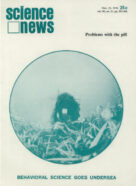Our recent article on the Earth’s magnetic poles flip caught your imagination, despite it being long.
So when I came across this article from Science News 50 years ago I thought you might find interesting.

As you know, the Earth’s magnetic field tends to flip every 1 million to 100 million years and we’re around 500,000 years late according to average predictions.
Now, some scientists now suspect think these flips may have had drastic effects on some species.
During the past 2.5 million years, eight species of one-cell marine animals called Radiolaria became extinct. Six of these extinctions occurred simultaneously throughout their geographic range immediately following magnetic reversals.

The earliest known radiolaria date to the very start of the Cambrian period, appearing in the same beds as the first small shelly fauna—they may even be terminal Precambrian in age.
Ninety percent of radiolarian species are extinct. The skeletons, or tests, of ancient radiolarians are used in geological dating, including for oil exploration and determination of ancient climates.
Higher concentrations of dissolved carbon dioxide (CO2) in sea water dissolves their fine skeletons made of silica, destroying their delicate structure, seen as fractured scattered pieces under a microscope. This is linked to periods of heightened volcanic activity – which seems to attend magnetic pole flips and Grand Solar Minima such as we are experiencing right now.
If you are interested in this kind of thing I strongly recommend you follow Electroverse on Facebook.
